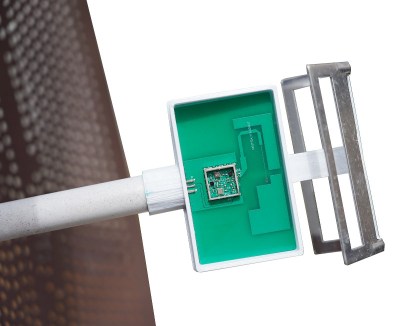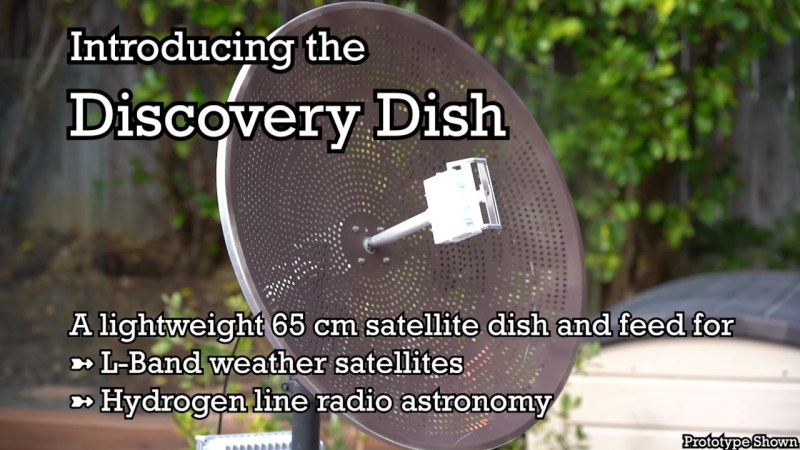These days, affordable software defined radios (SDRs) have made huge swaths of the spectrum available to hobbyists. Whether you’re looking to sniff the data from that 433 MHz thermometer you’ve got in the backyard or pick up transmissions from satellites, the same little USB-connected box can make it happen.
But even the best SDR is constrained by the antenna it’s connected to, and that’s where it can still get a little tricky for new players. Luckily, there’s a new option for those who want to pick up signals from space without breaking the bank: the Discovery Dish by KrakenRF. After reaching 105% of its funding goal on December 20th, the handy little 65-cm aluminum reflector looks like it’s on track to ship out this summer.
 The Discovery Dish was designed from the ground up to enable hobbyists to receive real-time weather data from satellites transmitting in the L band (GOES, NOAA, Meteor, etc.) and experiment with hydrogen line radio astronomy. Neither of which are anything new, of course. But having a pre-built dish and feed takes a lot of the hassle out of picking up these distant signals.
The Discovery Dish was designed from the ground up to enable hobbyists to receive real-time weather data from satellites transmitting in the L band (GOES, NOAA, Meteor, etc.) and experiment with hydrogen line radio astronomy. Neither of which are anything new, of course. But having a pre-built dish and feed takes a lot of the hassle out of picking up these distant signals.
Although the current prototype has a one-piece reflector, the final Discovery Dish will break down into three “petals” to make storage and transport easier. If you don’t want to take it all the way apart, you can simply remove the feed to make it a bit more compact. Speaking of which, KrakenRF is also offering three different feeds depending on what signals you’re after: L band, Inmarsat, or hydrogen line.
You still have options if you’ve got to keep your radio hacking on a tighter budget. As we saw recently, you can actually pull an ET and pick up weather satellites using a foil-lined umbrella. Or spend a little at the big box hardware store and grab some aluminum flashing.
















It looks like a pasta strainer.
A fellow pastafarian, maybe?
Why are the holes….random? Can i just bolt another feed to my 10ft c-band dish?
From the link: “The photos shown here feature an early antenna prototype that is a single piece with roughly laser-cut wind holes. Once crowdfunding has completed, we will produce the molds for the three-petal version that will ship to backers. The production version will obviously be a lot neater looking”
Any parabolic will work as long as you can mount your feed on it correctly. Not sure why the world needs a new dish. The perforations wont significantly affect wind load of a dish this small (see every sat tv dish out there).
Why are the holes spaced in such an unusual pattern?
looks like this prototype was drilled by hand. I see fresh metal on the inside of the holes
i think it’s just to save weight and nothing else
I according to the crowdsupply page they are wind holes.
“The photos shown here feature an early antenna prototype that is a single piece with roughly laser-cut wind holes.”
I am guessing they where using a CNC machine of some kind to drill the holes and had issues securing the work piece down. Gradually the work piece came loose and eventually they needed to stop the machine and secure the work before restarting. Looks like this happened several times to varying degrees of misalignment.
I quite like the pattern, maybe they should keep it. Perhaps encode something into the pattern like NASA did on a parachute.
I originally saw the prototype image a while back, laughed and moved on instantly. But now that I see that it is a portable three petal design I’m interested. if it is parabolic it could even be used for audio applications.
I wonder if they’ll sell just the feeds to use with a cheap, used satellite TV dish for those who don’t want to make their own feeds from content available on-line…
Yeah, that or you can buy a $99 GOES antenna on Amazon right now. Is there something that this can do that any other small parabolic antenna can’t do ? I cant believe it is cost effective to try to manufacture your own parabolic dish given how common they are for everything from directional wifi to sat tv. The dish is just a parabola, there is nothing new under the sun there. The LNA being interchangeable might be unique but if they just built LNA mounts to fit ubiquitous sat tv dishes that would be a better use of their time. I think our weather station at my Air Force base was using a small helical for GOES but the parabolic would be better for weaker stuff.
Check out this link to see it done with a wifi antenna or a homemade helical.
https://cimss.ssec.wisc.edu/education/flashtalks/Sept/DIY%20GOES-R%20HRIT.pdf
nice, thanks for sharing.